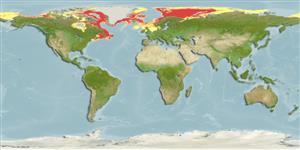Environment: milieu / climate zone / depth range / distribution range
นิเวศวิทยา
เกี่ยวกับทะเล,น้ำเค็ม สัตว์น้ำหน้าดิน; ระดับความลึก 25 - 1187 m (Ref. 58426). Polar; 84°N - 42°N, 180°W - 180°E
Arctic: Arctic Alaska, Smith Sound, northwest Greenland, Kara Sea, Barents Sea, off Spitsbergen, coast of Norway, Wyville-Thomson Ridge, Iceland, northeast Greenland, and localities off western Greenland.
ขนาด / น้ำหนัก / Age
Maturity: Lm ? range ? - ? cm
Max length : 44.5 cm SL เพศผู้/กระเทย; (Ref. 11976)
Benthic; feeds on crustaceans (Ref. 58426). Switches feeding habits with increasing size. Smaller eelpouts eat mainly endobenthic prey, larger individuals feed more on epibenthic prey (Ref. 13532).
Life cycle and mating behavior
Maturities | การสืบพันธุ์ | Spawnings | Egg(s) | Fecundities | ตัวอ่อน
McAllister, D.E., M.E. Anderson and J.G. Hunter, 1981. Deep-water eelpouts, Zoarcidae, from Arctic Canada and Alaska. Can. J. Fish. Aquat. Sci. 38(7):821-839. (Ref. 11976)
IUCN Red List Status (Ref. 130435)
Threat to humans
Harmless
Human uses
เครื่องมือ
Special reports
Download XML
แหล่งที่มาจากอินเตอร์เน็ต
Estimates based on models
Preferred temperature (Ref.
123201): -0.9 - 4, mean 0.8 °C (based on 1789 cells).
Phylogenetic diversity index (Ref.
82804): PD
50 = 0.5000 [Uniqueness, from 0.5 = low to 2.0 = high].
Bayesian length-weight: a=0.00251 (0.00156 - 0.00403), b=3.21 (3.07 - 3.35), in cm total length, based on LWR estimates for this species & Genus-body shape (Ref.
93245).
ระดับชั้นอาหาร (Ref.
69278): 3.5 ±0.50 se; based on food items.
ความสามารถในการกลับคืนสู่ปกติ (Ref.
120179): ต่ำมาก, เวลาต่ำสุดที่จะทำให้ประชากรเพิ่มขึ้นเป็น 2 เท่าใช้เวลามากกว่า 14 ปี (Preliminary K or Fecundity.).
Fishing Vulnerability (Ref.
59153): Moderate vulnerability (42 of 100).
